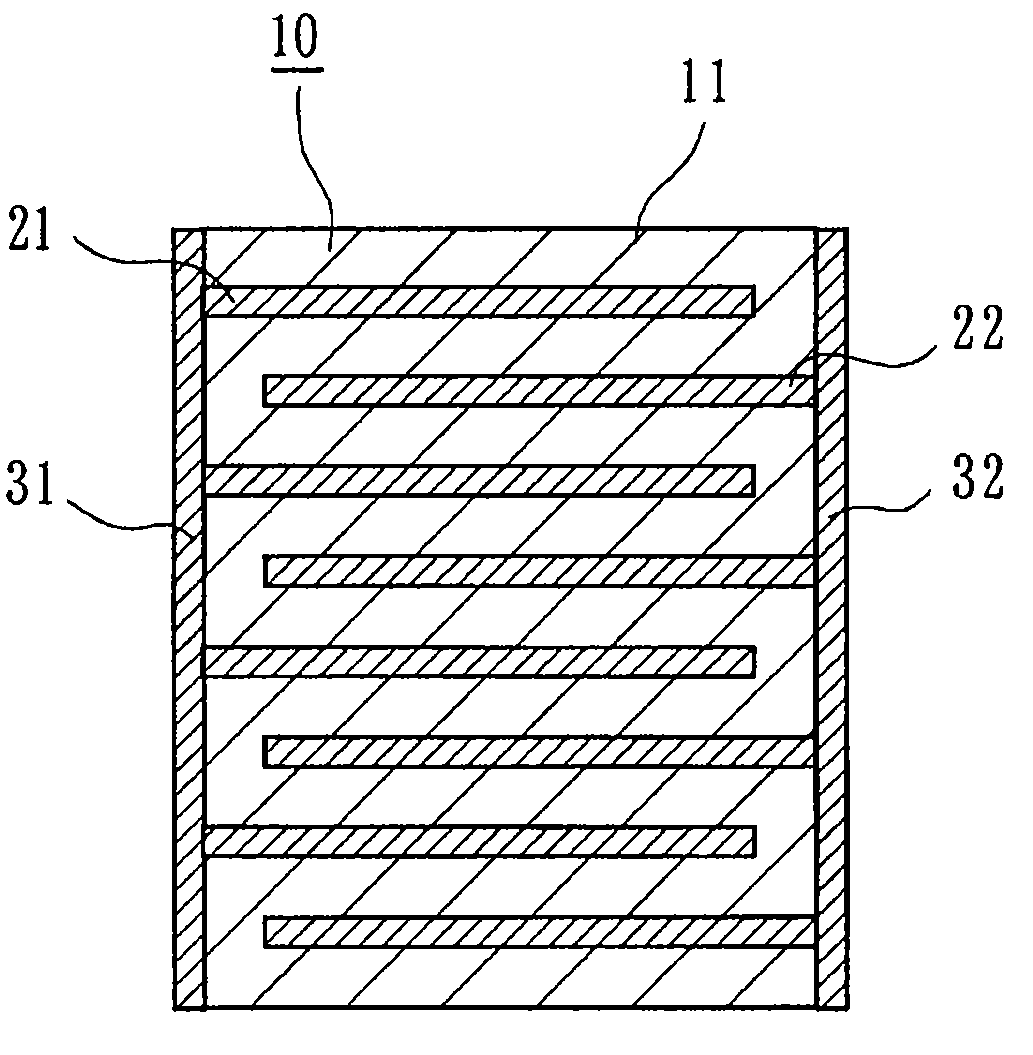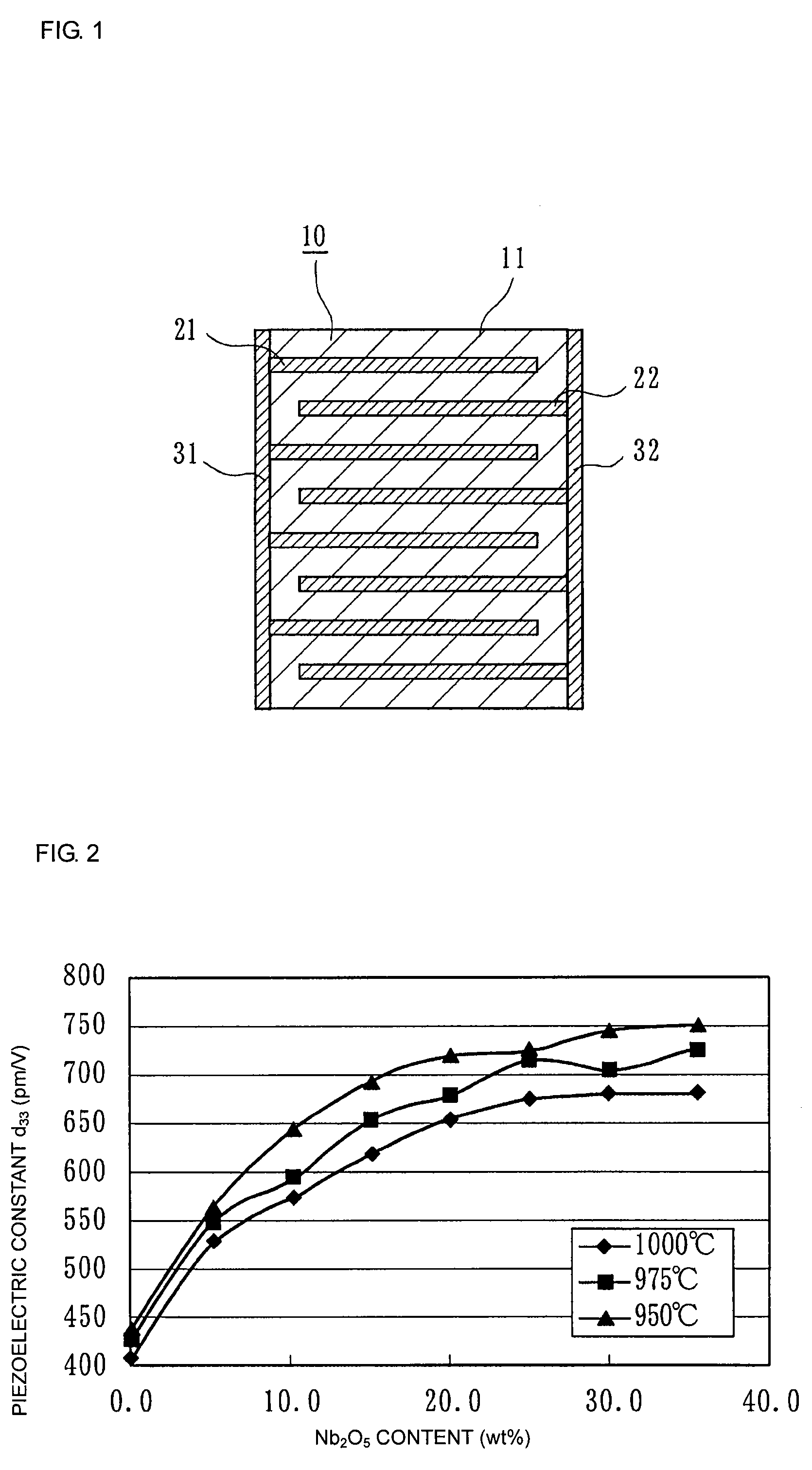Laminated piezoelectric element and process for producing the same
a piezoelectric element and piezoelectric technology, applied in piezoelectric/electrostrictive/magnetostrictive devices, basic electric elements, generators/motors, etc., can solve the problem of high price of pd, achieve good piezoelectric constant, improve sinterability, and effectively charge compensation
- Summary
- Abstract
- Description
- Claims
- Application Information
AI Technical Summary
Benefits of technology
Problems solved by technology
Method used
Image
Examples
example 1
[0055]First, as starting materials for a piezoelectric ceramic, Pb3O4, TiO2, ZiO2, NiO, ZnO, and Nb2O5 powders are prepared and weighed so as to satisfy the composition shown in compositional formula (1) below.
Pb{(Ni1 / 3Nb2 / 3)0.1(Zn1 / 3Nb2 / 3)0.1Ti0.42Zr0.38}O3 (1)
[0056]The weighed starting materials were mixed and pulverized for 16 hours, and then calcined at 880° C. to obtain calcined powder of the piezoelectric ceramic. The calcined powder was kneaded with a binder and a plasticizer, and piezoelectric ceramic green sheets with a thickness of 120 μm were obtained by a doctor blade process.
[0057]Next, as conductive powders, a Cu powder and a Ni powder were prepared, and as a metal oxide containing a pentavalent metal element, Nb2O5 was prepared.
[0058]Then, the Cu powder, the Ni powder, and Nb2O5 were weighed so that the ratio of the Cu powder content to the Ni powder content, in terms of weight, was 85:15 and the Nb2O5 content was 0% to 40% by weight on the basis of the total solid c...
example 2
[0078]Multilayer piezoelectric devices of Sample Nos. 11a to 19c were fabricated by the same method and procedure as in [Example 1] except that WO3 containing a hexavalent metal element was used, instead of Nb2O5, as the metal oxide incorporated in the internal electrode pattern.
[0079]Next, with respect to Sample Nos. 11a to 19c, the piezoelectric constant d33 was calculated by the same method and procedure as in [Example 1]. Furthermore, with respect to the samples in each of Sample Nos. 11b, 12b, and 15b, the concentrations (contents) of WO3 and CuO were measured using a WDX (wavelength dispersive X-ray spectrometer).
[0080]Table 3 shows the WO3 content on the basis of the total solid content in the internal electrode pattern, the firing temperature, and the piezoelectric constant d33 in each sample, and Table 4 shows the concentrations of WO3 and CuO at each measuring point in the piezoelectric ceramic layer.
[0081]
TABLE 3FiringPiezoelectricSampleWO3 contenttemperatureconstant d33N...
PUM
 Login to View More
Login to View More Abstract
Description
Claims
Application Information
 Login to View More
Login to View More - R&D
- Intellectual Property
- Life Sciences
- Materials
- Tech Scout
- Unparalleled Data Quality
- Higher Quality Content
- 60% Fewer Hallucinations
Browse by: Latest US Patents, China's latest patents, Technical Efficacy Thesaurus, Application Domain, Technology Topic, Popular Technical Reports.
© 2025 PatSnap. All rights reserved.Legal|Privacy policy|Modern Slavery Act Transparency Statement|Sitemap|About US| Contact US: help@patsnap.com



